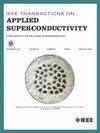Bi2Sr2CaCu2O8+x线纵向应变对临界电流依赖性的致密化效应
IF 1.8
3区 物理与天体物理
Q3 ENGINEERING, ELECTRICAL & ELECTRONIC
引用次数: 0
摘要
毫无疑问,将Bi2Sr2CaCu2O8+x (Bi-2212)超导圆线应用于20t以上的超高场是一个新的研究方向。我们通过比较在5和50 bar超压下反应的样品的临界电流Ic对纵向应变柱的依赖,研究了在高质量的Bi-2212线中灯丝致密化的影响。我们用于传输Ic(柱)测量的沃尔特斯弹簧装置具有高灵敏度,有助于检测不可逆损伤的首次发作,以及确定描述Ic(柱)从弱依赖到陡峭依赖转变的其他特征应变。结果表明,由于致密化,所有的拉伸特征应变都有显著的改善。例如,不可逆应变极限ϵirr的平均值从5bar试样的0.3%增加到50bar试样的0.4%。此外,致密试样对应变的响应沿试样长度方向更为均匀,与所使用的测量模式无关。在16 T和4.2 K时,Ic增加了2.5倍,这些改进与此同时发生,这似乎是由于消除了在应变、非致密样品中集中应力的孔隙,而这些孔隙是裂纹的引发剂。另一方面,当应变值超过- 0.28%时,致密试样对纵向压缩的敏感性增加。在这种情况下,我们认为,与非致密样品相比,致密样品中Bi-2212材料的连续体促进了应变诱导屈曲缺陷的扩展,而非致密样品中的孔隙可能会减缓这种扩展并使损伤更局部化。然而,致密化的好处在很大程度上超过了高压缩下灵敏度的增加,因为Ic仍然明显高于未致密化样品。这些结果揭示了灯丝致密化对导体应变性能的非常积极的影响,增加了它诱导的Ic的显著提升。本文章由计算机程序翻译,如有差异,请以英文原文为准。
Densification Effects on Critical-Current Dependence on Longitudinal Strain in Bi2Sr2CaCu2O8+x Wires
There is undoubted new interest in applying Bi2Sr2CaCu2O8+x (Bi-2212) superconducting round wires for ultra-high fields above 20 T. We investigated effects of filament densification in a high-quality Bi-2212 wire made with fine Engi-Mat powder by comparing critical-current Ic dependence on longitudinal strain ϵ among samples reacted under 5- and 50-bar overpressure during the partial-melt process. The Walters spring apparatus we used for transport Ic(ϵ) measurements had a high sensitivity that helps detect the first onset of irreversible damage, as well as determine other characteristic strains that describe the transition of Ic(ϵ) from weak to steeper dependences. Results show a noticeable improvement of all the tensile characteristic strains as a result of densification. For example, average value of the irreversible strain limit ϵirr increased from 0.3% for 5-bar samples to 0.4% for 50-bar specimens. Moreover, the response of densified samples to strain was significantly more homogeneous along the sample length, independent of the measurement mode used. These improvements, which happened in conjunction with an increase of Ic by a factor 2.5 at 16 T and 4.2 K, are plausibly due to the elimination of pores that can concentrate stress in strained, nondensified samples where they act as crack initiators. Sensitivity of densified samples to longitudinal compression, on the other hand, increased for strain values beyond −0.28% . In this case, we believe that the continuum of Bi-2212 material in densified samples facilitates the propagation of strain-induced buckling defects as compared to nondensified samples where pores may slow this propagation and keep damage more localized. The benefits of densification, nevertheless, largely outweigh this increase of sensitivity at high compression as Ic remained significantly higher than that of nondensified samples. These results reveal very positive effects of filament densification on the conductor's strain properties that add to the significant boost of Ic it induces.
求助全文
通过发布文献求助,成功后即可免费获取论文全文。
去求助
来源期刊

IEEE Transactions on Applied Superconductivity
工程技术-工程:电子与电气
CiteScore
3.50
自引率
33.30%
发文量
650
审稿时长
2.3 months
期刊介绍:
IEEE Transactions on Applied Superconductivity (TAS) contains articles on the applications of superconductivity and other relevant technology. Electronic applications include analog and digital circuits employing thin films and active devices such as Josephson junctions. Large scale applications include magnets for power applications such as motors and generators, for magnetic resonance, for accelerators, and cable applications such as power transmission.
 求助内容:
求助内容: 应助结果提醒方式:
应助结果提醒方式:


